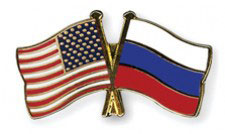US, Russia continue to forge research collaborations
July / August 2013 | Volume 12, Issue 4
By Arthur Allen
US, Russia talks explore shared research interests
Substance abuse, tobacco control, cardiovascular disease prevention and childhood obesity were some of the topics U.S. and Russian health officials discussed during the recent World Health Assembly in Geneva. It was the third meeting of the U.S.-Russia Bilateral Presidential Commission's Health Working Group, which is exploring potential areas for collaboration. The U.S. delegation was led by HHS Secretary Kathleen Sebelius (right) and included Office of Global Affairs Director Dr. Nils Daulaire, as well as Fogarty Director Dr. Roger I. Glass.
Second US-Russia Scientific Forum meeting held at NIH
Pediatric and rare diseases hold promise for research partnerships and were the topics of discussion during the second meeting of the U.S.-Russia Scientific Forum held at NIH. The two countries share a number of pressing health problems and research interests and could benefit from working together, delegates agreed.
 "We have to destroy the walls between us," said Dr. Leyla Namazova-Baranova, director of the Institute of Preventive Pediatrics and Rehabilitation in Moscow. "Sharing experiences is key."
"We have to destroy the walls between us," said Dr. Leyla Namazova-Baranova, director of the Institute of Preventive Pediatrics and Rehabilitation in Moscow. "Sharing experiences is key."
Following scientific presentations, participants discussed ways that investigators from the two countries could build research relationships. All agreed that rare diseases are a particularly fruitful area for collaboration because the relatively small numbers of patients make it vital to gather evidence from around the world. "We must work together, or we'll never be able to come up with therapies and ways to manage these cases," said Namazova-Baranova.
"Private sources aren't as interested in funding research into these illnesses because of the lack of a likely commercial payout," added Dr. Vesna Kutlesic, director of the Office of Global Health at the National Institute of Child Health and Human Development (NICHD). "This is an area where bilateral government action can bring scientists together to fill a gap."
Fogarty director Dr. Roger I. Glass and other attendees spoke of creating formal research networks, as well as using opportunities such as the Forum to promote linkages between specific scientists and laboratories. U.S. fellowships for visiting young Russian scholars could help build these ties, participants agreed. (Learn more about US-Russia Collaboration in the Biomedical Sciences NIH Visiting Fellows Program from the Foundation for NIH.) It would also be beneficial to hold satellite meetings of U.S. and Russian scientists during international conferences.
"These programs are based on the shared interests of investigators who are so impassioned by the science that they are willing to overcome all hurdles to make the research go forward," Glass said during the session. "This Forum is really about matchmaking - getting young scientists, both American and Russian, together for research so that five years from now we’ll have really unusual discoveries that couldn’t have been imagined otherwise."
The Russian delegation was hosted by NICHD, Fogarty and the Office of Rare Diseases, part of the National Center for Advancing Translational Sciences (NCATS). During their stay, the group met with NIH counterparts, visited the pediatrics department at Children's National Medical Center and attended the annual meeting of the Pediatric Academic Societies.
The U.S.-Russia Scientific Forum was established in 2011 and is a public-private partnership coordinated by the Foundation for the NIH (FNIH). The Forum, created with support from Eli Lilly and Company, is intended to promote and facilitate broader research collaboration in the biomedical and behavioral sciences between the two countries, with the goal of improving public health. Joint areas of interest include disease control, treatment and prevention, clinical and translational research, regulatory science and the development of new health technologies.
More Information
To view Adobe PDF files,
download current, free accessible plug-ins from Adobe's website.